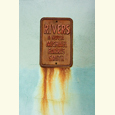Finding Roots in Rubble
Preparing for the birth of her first child, Hannah Palmer tries to find her own childhood
When Hannah Palmer and her husband return from New York to their home town, they find that the Atlanta of their childhood has been forever changed by the “world’s busiest airport,” and Palmer sets out to tell the story of what happened there. Part memoir and part investigative journalism, Flight Path is a compelling read for anyone who lives in a rapidly-growing city.

Atlanta has a lot going for it: major sports teams, corporate headquarters for Coca-Cola and CNN, as well as the King Center, the Centers for Disease Control, several universities, and a thriving film industry. But what it’s truly known for is its airport. And for good reason: as Palmer notes, the Hartsfield-Jackson Atlanta International Airport has become the “economic engine for the entire Southeast region. In 2014, Hartsfield-Jackson boasted a direct economic impact of more than about $32.5 billion for the Metro Atlanta economy, which means Atlanta’s gross domestic product is larger than that of thirty states. And 63,000 people work at the airport, making it the largest employer in the region.”
According to Palmer, most people who travel to Jackson-Hartsfield are simply connecting to another flight. They never leave the airport, never know the neighborhoods its presence has altered: “Even many native Atlantans don’t realize that the airport was built on top of neighborhoods,” she writes, “or that its expansion has a devastating effect on the city’s southside.”
Palmer’s personal history serves as an example. The house on Barnett Road where she lived with her father and sister after their mother left, like all the other houses on the road, is gone, “replaced by a warehouse complex called Air Logistics Center II.” The house where the family lived after Palmer’s father remarried is now a CVS. Her mother’s house, where she stayed one college summer and lost her virginity, is also gone.
 Palmer—who works as an urban planner in Atlanta and who earned her M.F.A. in creative writing from the University of the South in Sewanee—does a thorough job of tracking down these neighborhoods and those who still remember them. She also shows how white flight and the airport’s growth connect along the way.
Palmer—who works as an urban planner in Atlanta and who earned her M.F.A. in creative writing from the University of the South in Sewanee—does a thorough job of tracking down these neighborhoods and those who still remember them. She also shows how white flight and the airport’s growth connect along the way.
But some of the more memorable parts of this book are the personal moments she recounts. One woman tears up as she and her husband take Palmer on a tour of the old neighborhood: “This is why I don’t come back here,” she says. “There is nothing left of our childhood.” Neighborhood Facebook groups share photographs and memories as if to prove that their childhood stomping grounds did actually exist. Even current memories are at risk: the summer after Palmer’s first son is born, South Fulton Medical Center closes its Women’s Services Department. “Uncle David was one of the first babies born at South Fulton in 1963,” Palmer writes. “My son, in 2011, would be among the last.”
Flight Path is an intriguing exploration of the way the old and the new can coexist even as the new destroys much of the old, for in these neighborhoods, people still recognize last names and ask the age-old question, “Are you any kin to …?” People still tell stories of their childhoods, even if the actual places where those events occurred are now gone. The airport may have obliterated the neighborhoods, but it has not obliterated the memories. At least not yet.

Faye Jones, dean of learning resources at Nashville State Community College, writes the Jolly Librarian blog for the college’s Mayfield Library. She earned her doctorate in nineteenth-century literature at Indiana University of Pennsylvania.


